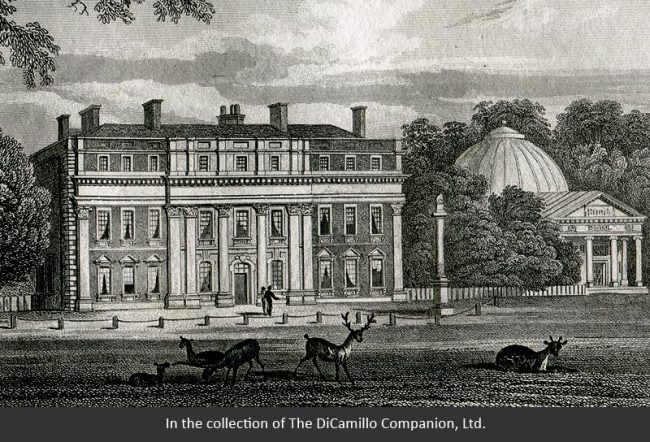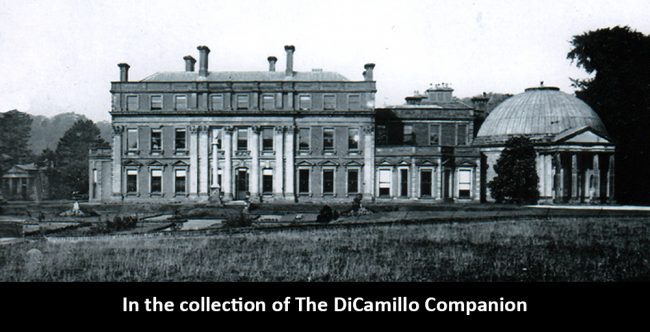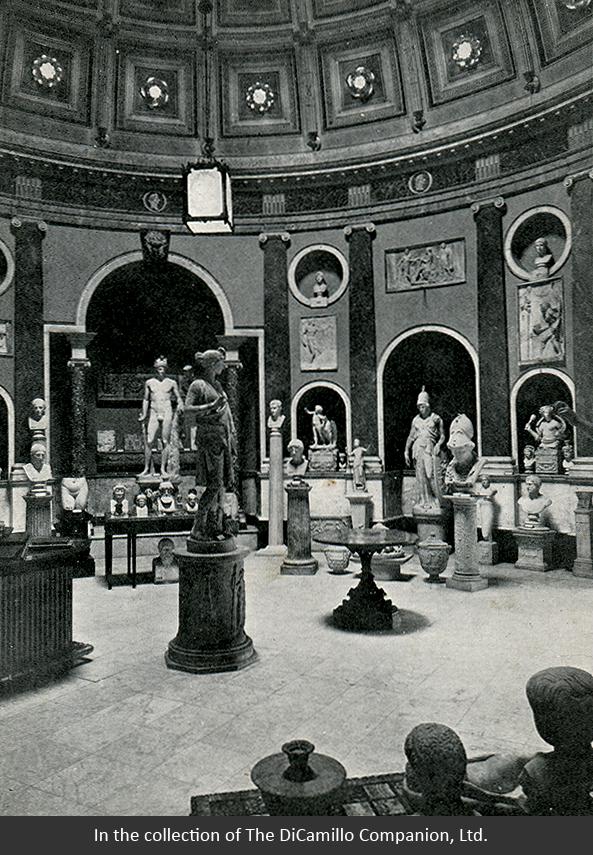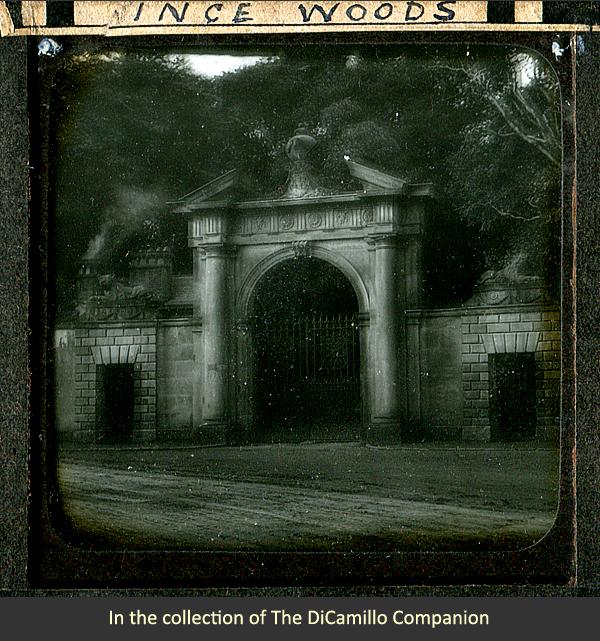
Engraving of the entrance facade from "Neale's Views of the Seats of the Noblemen and Gentlemen in England, Wales, Scotland and Ireland," 1824.

Photo of the entrance facade from a circa 1911 postcard

The interior of the Pantheon from an early 20th century photographic postcard

The Lion Gate from a circa 1910 magic lantern glass slide
Earlier Houses: There was an earlier house on the site of the current house.
Built / Designed For: Robert Blundell
House & Family History: The name Ince comes from Hinnem, a Celtic word meaning "island in the marsh," which derives from a time when Ince, which lies on a sandy ridge in the Alt Valley, was marshland. The Blundells (later the Weld-Blundells) were notable major landowners in Lancashire and a prominent Roman Catholic family. In the 14th century John Blundell added his surname to Ince to distinguish it from nearby Ince-in-Makerfield in Lancashire and Ince in Cheshire. The house was built circa 1720, with enlargements in 1800 and 1847-50. The famous Pantheon (a smaller stone version of the Roman Pantheon, complete with a lead dome and a tetrastyle Ionic portico) was added 1802-03 by Henry Blundell to display his collection of antique marbles (most of the collection was given to the Liverpool Museum circa 1960). The house was sold to the Catholic Church in the early 1960s and is today a nursing home run by the Augustinian Canonesses of the Mercy of Jesus, an order that carries out the traditional work of caring for the ill and disabled (the house was originally opened to care for ill and retired priests of the Archdiocese of Liverpool).
Collections: Henry Blundell's collection of ancient classical (Greek and Roman) sculpture, formed in the 18th century, was one of the most important in Britain, second only to that formed by Charles Townley of Towneley Hall (the latter is today in the collection of the British Museum). As Catholics in 18th century England, both Blundell and Townley were prohibited from attending the ancient universities, standing for Parliament, or serving in the military, so they used their wealth to collect art on a grand scale. Blundell acquired pieces from sales at the Villa d'Este and the Villa Mattei, including "Head of Jupiter" by Cavaceppi's pupil, Giuseppe Angelini, and "Artemis" by Bartolomeo Cavaceppi. The collection also featured 17th and 18th century Italian sculptures by artists such as Bartolomeo Cavaceppi and Carlo Albacini and very fine restorations, that of an antique vase by Giovanni Battista Piranesi being a prime example. There were also pieces now known to be forgeries: a bust of Otho and "Head of Lucius Verus." Henry Blundell originally built (in 1790) the Garden Temple to house his marbles; after the collection outgrew that space, he commissioned the spectacular Pantheon (a scaled-down version of the Roman original, which Blundell attached to his house). Built between 1802 and 1803, the Pantheon was the home of the collection until its dispersal. The ancient sculptures, including some from Hadrian's Villa at Tivoli, went to the World Museum in Liverpool, while many of the 18th century sculptures ended up in Liverpool's Walker Art Gallery, which also was the recipient of much of the furniture and paintings Blundell collected. Henry's son, Charles Robert Blundell (1761-1837), later donated a large collection of drawings to the Walker Art Gallery. Blundell's collection today remains primarily divided between the World Museum, the Walker, and Lulworth Castle, Dorset, where part of the collection can be seen in the Stables Art Gallery (the Weld family of Lulworth inherited marbles, furniture, and paintings when Ince Blundell was bequeathed to them). Please see the PDF in the "Related Resources" section for the mid-1950s notes and lists of Cornelius Clarkson Vermeule III, the late scholar of ancient art and classical curator at the Museum of Fine Arts, Boston, on the collection of ancient art at Ince Blundell.
Garden & Outbuildings: In 1790 a Tuscan garden folly (extant) was built for Henry Blundell to display his collection of classical sculpture; the collection was later transferred to the larger Pantheon, which was built in the early 19th century specifically to accommodate the expanding collection of ancient marbles. The house today is set in 50 acres of park and woodland.
Architect: William Everard
Date: 1790Architect: Joseph Michael Gandy
Date: Circa 1809Architect: Joseph John Scoles
Date: 1858-59John Bernard (J.B.) Burke, published under the title of A Visitation of the Seats and Arms of the Noblemen and Gentlemen of Great Britain and Ireland, among other titles: Vol. I, p. 16, 1852.
John Preston (J.P.) Neale, published under the title of Views of the Seats of Noblemen and Gentlemen in England, Wales, Scotland, and Ireland, among other titles: Vol. II, 1819.
Country Life: CXXIII, 756 plan, 816, 876, 1958.
Title: Britain's Best Museums and Galleries
Author: Fisher, Mark
Year Published: 2004
Reference: pg. 291
Publisher: London: Allen Lane
ISBN: 0713995750
Book Type: Hardback
Title: Biographical Dictionary of British Architects, 1600-1840, A - HARDBACK
Author: Colvin, Howard
Year Published: 2008
Reference: pgs. 371, 909-10, 912
Publisher: New Haven: Yale University Press
ISBN: 9780300125085
Book Type: Hardback
House Listed: Grade II*
Park Listed: Grade II*
Past Seat / Home of: SEATED AT CURRENT HOUSE: Robert Blundell, 1720-61; Henry Blundell, 1761-1810; Charles Robert Blundell, 1810-37; Thomas Weld-Blundell, 19th century; Weld-Blundell family here from the 14th century until the 1960s.
Current Ownership Type: Other
Primary Current Ownership Use: Hospital / Care Home / Recovery Center
Ownership Details: Today Ince Blundell Hall Nursing Home, operated by the Augustinian Canonesses of the Mercy of Jesus.
House Open to Public: No
Phone: 01519-292-596
Historic Houses Member: No